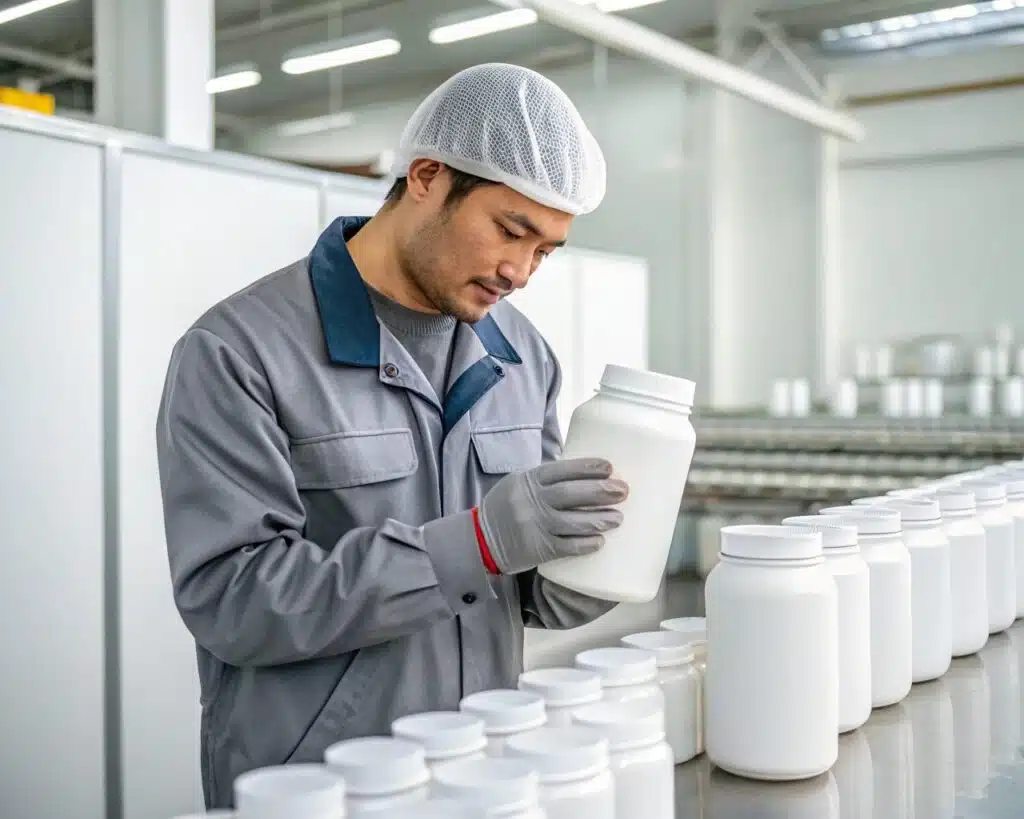Struggling with unreliable suppliers and rising costs for your PET wide-mouth jars? You're not alone. The constant back-and-forth, inconsistent quality, and long lead times can cripple your production and eat into your profits.
Bringing your PET wide-mouth jar production in-house with an integrated injection and blow molding line is the definitive solution. This approach gives you complete control over the entire process, from raw material to finished product, ensuring higher quality, lower costs, and greater flexibility.
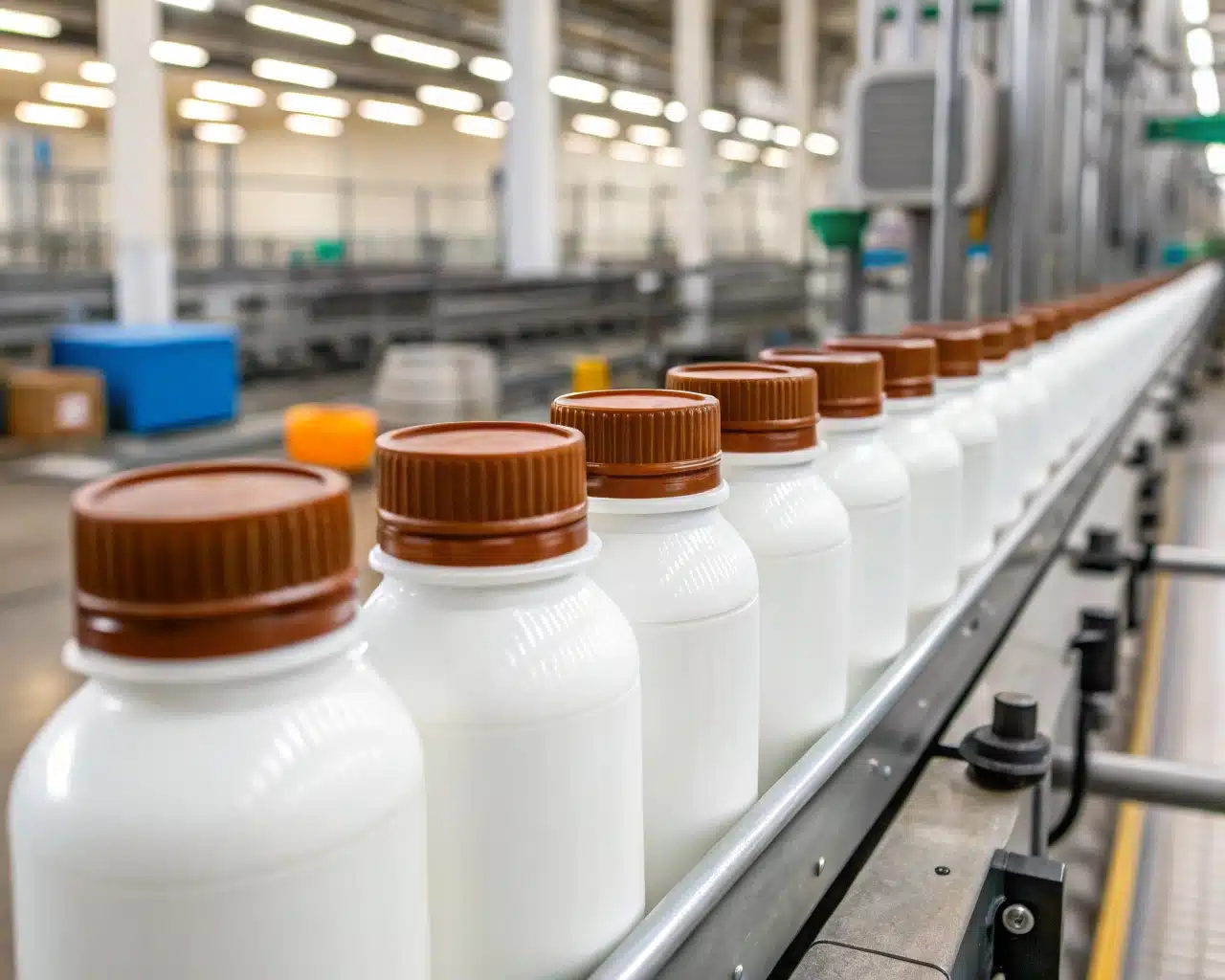
I’ve seen many businesses hesitate at the thought of setting up their own production line. It seems like a massive undertaking. However, the long-term benefits often far outweigh the initial investment. In my 16 years in the PET packaging industry, I've guided numerous clients through this transition, and the results consistently speak for themselves. The move to self-production isn't just about manufacturing containers; it's about taking control of your product's quality, your brand's reputation, and your financial future. Let's break down how this strategy can revolutionize your business.
Still Outsourcing PET Jars? Are You Facing These Hidden Problems?
Are you constantly chasing suppliers for delivery updates? Do unexpected cost increases for your PET wide-mouth jars throw your budgets into disarray? These are common frustrations when you rely on outsourcing.
Outsourcing PET wide-mouth jars often leads to critical issues with delivery times, fluctuating costs, and inconsistent quality, especially with crucial neck tolerances. These problems can create production bottlenecks, hurt your brand, and shrink your profit margins over time.

For over a decade and a half, I've worked in the PET plastic packaging sector. A clear trend I've noticed recently is the shift towards the PET wide-mouth jar market. Why? It’s less saturated than the PET water bottle market, which means higher profit margins. However, many companies that are experts in producing standard PET bottles stumble when they venture into wide-mouth jars. The production process has some key differences. Outsourcing seems like an easy entry, but it often brings a host of problems that can be more damaging in the long run. Let's dive deeper into the specific challenges you might be facing.
The True Cost of Outsourcing
When you outsource, the price you're quoted is just the beginning. There are many hidden costs and operational headaches that don't appear on the initial invoice.
- Lead Time Instability: Your supplier is juggling multiple clients. This means your order is just one in a long queue. Any disruption on their end, whether it's a machine breakdown or a larger client placing a rush order, can push your delivery date back by weeks or even months. This unpredictability makes it nearly impossible for you to plan your own production schedules effectively.
- Inconsistent Neck Tolerances: The neck of a wide-mouth jar is critical for a proper seal. When you outsource, you're at the mercy of your supplier's quality control, which can be inconsistent from one batch to the next. Poorly fitting lids lead to customer complaints, product spoilage, and potential recalls, all of which damage your brand's reputation.
- Creeping Costs: The price of raw materials fluctuates. Transportation costs can change. Your supplier might decide to increase their margins. These cost increases are passed directly on to you, often with little warning. This makes budgeting a nightmare and erodes your profitability.
| Outsourcing Challenge | Direct Impact on Your Business | Long-Term Consequence |
|---|---|---|
| Unreliable Lead Times | Production delays and inability to meet customer demand. | Loss of market share and damaged customer relationships. |
| Poor Quality Control | Higher defect rates, wasted inventory, and product leakage issues. | Tarnished brand reputation and costly recalls. |
| Hidden Cost Increases | Unpredictable expenses and shrinking profit margins. | Reduced competitiveness and financial instability. |
These issues are not just minor inconveniences; they are significant business risks that can be almost entirely eliminated by bringing production in-house.
What is an Integrated Injection + Blow Molding Production Line?
Ever wondered how a small plastic pellet becomes a crystal-clear, sturdy jar? The magic happens in a seamless, automated process. It’s a solution that combines two key stages into one highly efficient system.
An integrated "injection + blow molding" production line is a turnkey system that automates the entire jar manufacturing process. It starts by injection molding a preform and then immediately transfers it to be blow-molded into the final jar shape, all within one continuous, automated sequence.
I find that many people new to the wide-mouth jar market are surprised by the efficiency of modern production lines. They picture a complex, multi-stage process with lots of manual handling. The reality is quite different. The integrated line I helped a client in Cameroon set up is a perfect example. They were struggling in the saturated water bottle market and wanted to tap into the more profitable candy jar business. Their new line is fully automated. A robotic arm moves the freshly made preforms from the injection molder onto a conveyor. The conveyor carries them to the bottle blowing machine, where another robot loads them for blowing. The entire process, from pellet to jar, is hands-free, fast, and incredibly consistent.
The Two-Step Process Explained
The "inject and blow" method is a two-step process that offers superior control and quality compared to other methods. Here's a simple breakdown:
-
Step 1: Injection Molding the Preform
- PET (Polyethylene Terephthalate) resin pellets are dried to a precise moisture level.
- The dried resin is fed into an injection molding machine, where it is melted and injected under high pressure into a multi-cavity preform mold.
- This creates a "preform," which looks like a thick test tube with the final neck finish of the jar already formed. This stage is critical because it defines the all-important neck dimensions and the overall weight of the final jar.
-
Step 2: Stretch Blow Molding the Jar
- The warm preforms are transferred, often by a robotic arm, to the reheat stretch bottle blowing machine.
- Inside, the preforms are reheated to a precise temperature to make them pliable.
- A steel rod (stretch rod) then stretches the preform vertically while high-pressure air inflates it horizontally, pushing it against the walls of the blow bottle mold.
- The jar is then rapidly cooled to set its shape before being ejected from the machine, ready for filling.
This integrated approach ensures that the preform is at the optimal temperature for blowing, which minimizes defects and maximizes clarity and strength. The automation between the two stages eliminates the risk of contamination or damage that can occur when preforms are made and stored separately.
Why Is Making Your Own Wide-Mouth Preforms a Game-Changer?
Do you feel like you're compromising on your jar's quality? When you buy preforms from a third party, you're essentially buying their standards, not defining your own. This is where the real control begins.
Making preforms in-house gives you unparalleled control over the most critical aspects of your jar: the neck finish for a perfect seal, the precise weight for cost efficiency, and the batch-to-batch consistency that ensures every single jar is perfect.
When you control the preform, you control the final product. It’s that simple. I've seen clients struggle for years with leaky caps or jars that are heavier than they need to be, wasting material and money on every single unit. By investing in their own preform mold and injection system, they eliminate these problems at the source. It allows you to fine-tune every detail, ensuring the preform is perfectly optimized for your specific jar design and the bottle blowing machine you use. This initial stage of production is where quality is born, and having it under your own roof is a massive strategic advantage.
Precision Control Where It Counts Most
Creating your own preforms allows you to master three vital elements that are often compromised when outsourcing.
- Absolute Precision on Neck Dimensions: The thread, neck ring, and sealing surface of a jar must be perfect. Any deviation can lead to improper sealing, causing leaks and reducing the shelf life of the product inside. When you produce your own preforms with a high-quality preform mold, you can dial in these dimensions to the tightest tolerances, ensuring every lid fits perfectly every time.
- Mastery Over Jar Weight (Grammage): The weight of the preform directly determines the weight of the final jar. A heavier jar costs more in raw materials. By making your own preforms, you can optimize the weight, reducing it to the minimum required for strength and performance without wasting a single gram of PET resin. Over millions of jars, these savings add up significantly.
- Unbeatable Consistency: Outsourced preforms can vary in quality from batch to batch or even within the same shipment. In-house production ensures every preform is made under the same conditions, with the same settings, every single day. This consistency translates directly to a more stable blowing process, with fewer rejects and a higher overall yield of top-quality jars.
| Feature Control | Benefit of In-House Preform Production | Impact on Final Product |
|---|---|---|
| Neck Finish | Micro-adjustments to the mold for perfect tolerances. | Guarantees a secure, leak-proof seal with the cap. |
| Preform Weight | Ability to optimize material usage down to the fraction of a gram. | Lower material costs and a more sustainable footprint. |
| Material Quality | Direct control over the PET resin source and drying process. | Higher clarity, better strength, and consistent performance. |
This level of control is simply not achievable when you are just a customer on a long list at a large preform manufacturer.
How Much More Customization Can You Really Get?
Are you tired of being told your unique jar design is "not possible" or "too expensive"? Outsourced manufacturing often forces you to choose from a limited menu of standard options, stifling your brand's creativity.
Bringing production in-house unlocks a world of customization. You gain the freedom to flexibly adjust neck sizes, create unique and proprietary jar shapes, and produce a vibrant spectrum of custom colors, setting your product apart on the shelf.
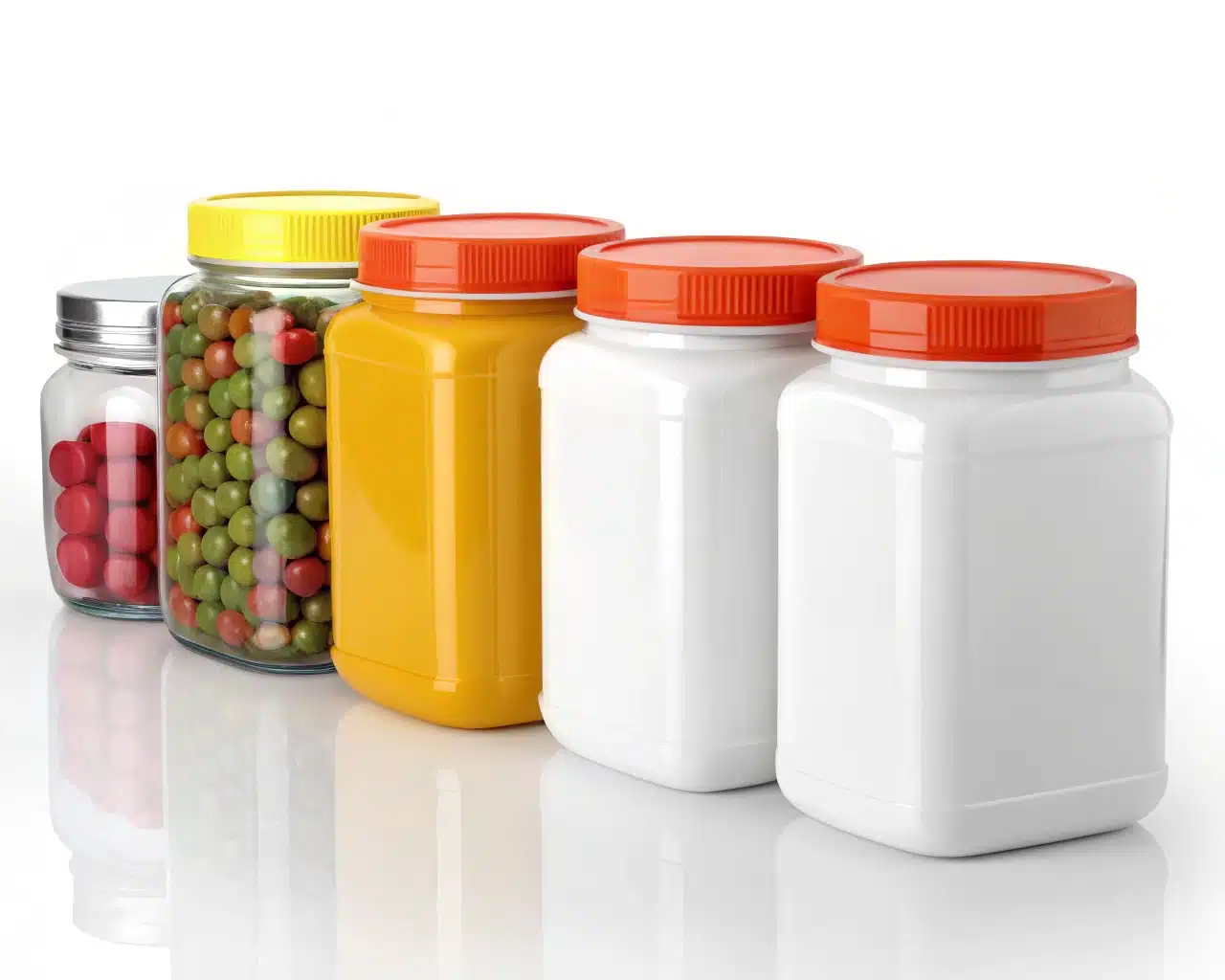
I believe packaging is a silent salesman. A unique container can grab a customer's attention and communicate the quality of the product inside before they even read the label. I remember working with a honey producer who wanted a jar shaped like a honeycomb. Every supplier they approached said no or quoted an astronomical price for a custom mold. By setting up their own integrated line, they were not only able to produce their dream jar but could also offer it in different sizes for different honey varieties. They even created a special amber-colored PET to mimic the color of their premium honey. This level of branding control is priceless.
Unlocking Your Brand's Creative Potential
An in-house line puts you in the designer's seat. You are no longer limited by a supplier's catalog.
- Flexible Neck Sizes: Need a specific neck diameter to fit a custom-designed dispensing cap or a tamper-evident seal? No problem. With your own preform mold, you can design and produce any neck finish you require, ensuring perfect compatibility with your chosen closures. This opens up possibilities for innovative features that can improve the consumer experience.
- Proprietary Jar Shapes: Your product is unique, and its packaging should be too. In-house production allows you to break free from standard round or square jars. You can design a container with unique contours, embossed logos, or an ergonomic grip that makes your product instantly recognizable. This requires a custom blow bottle mold, which is a core part of your in-house capability. A distinctive shape is a powerful tool for building brand equity.
- A Rainbow of Color Options: Color can evoke emotion and differentiate product lines. Instead of being limited to clear, white, or amber, you can create jars in any custom color imaginable. By simply adding colorant concentrate (masterbatch) to your PET resin, you can produce jars that perfectly match your brand's color palette. This is a simple yet highly effective way to stand out in a crowded retail environment.
| Customization Area | Standard Outsourcing | In-House Production Advantage |
|---|---|---|
| Neck Finish | Limited to supplier's standard sizes (e.g., 89mm, 110mm). | Any custom size and thread configuration is possible. |
| Jar Shape | Generic round, square, or oval shapes. | Unique, proprietary designs that become part of your brand identity. |
| Jar Color | Typically restricted to clear, white, and a few standard colors. | Unlimited custom color matching for strong brand differentiation. |
With an integrated line, your imagination is the only limit. You can test new designs quickly, adapt to market trends, and create a packaging portfolio that truly represents your brand.
Will Your Product Quality and Consistency Really Improve?
Do you find yourself dealing with too many customer complaints about inconsistent product quality? Defects, leaks, and variations from one jar to the next can erode trust in your brand and lead to costly returns.
Yes, absolutely. An integrated production line dramatically improves product consistency and lowers defect rates. By controlling every variable from resin to final jar, you can maintain a stable, high-yield process that produces consistently flawless containers.
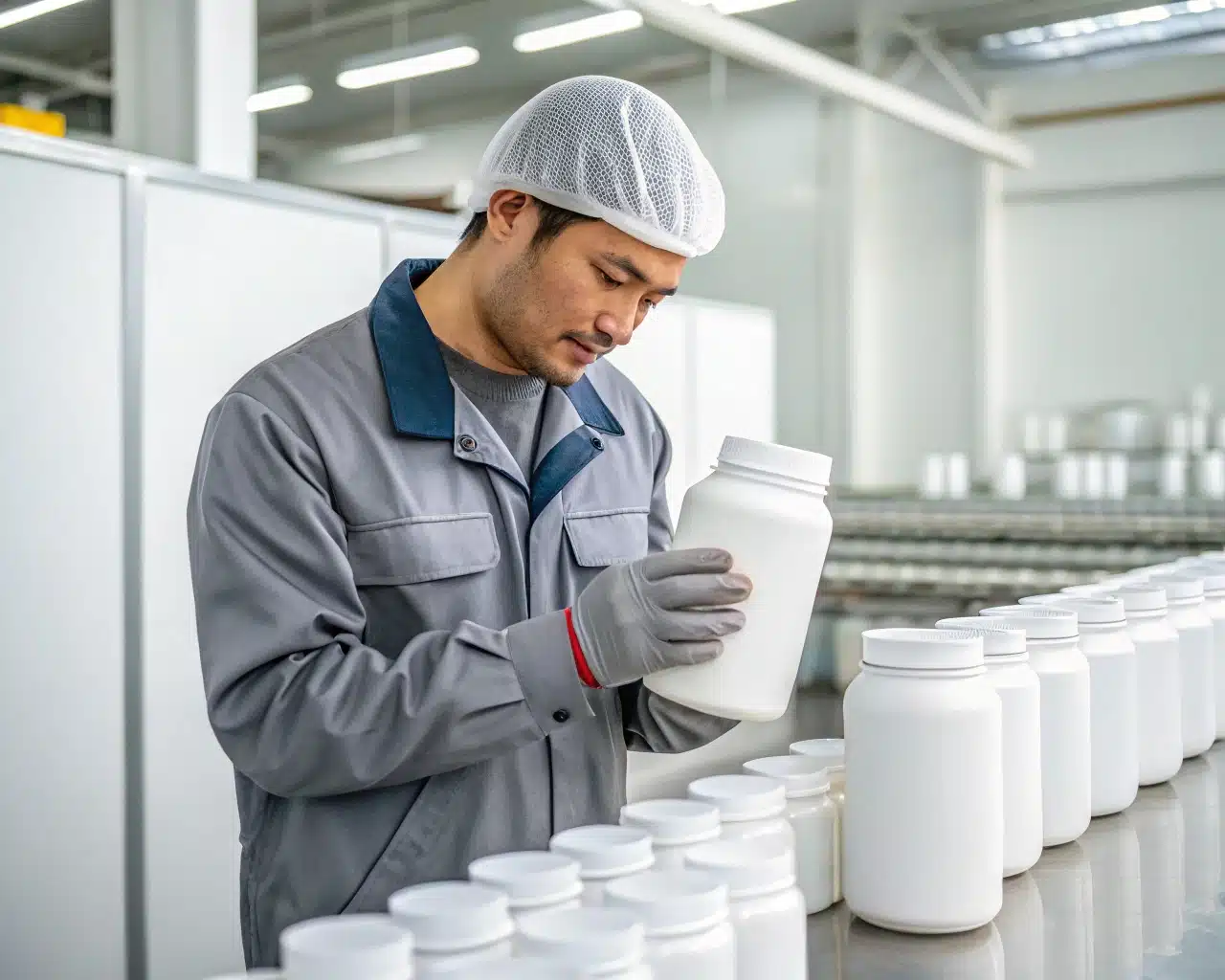
The case of my client in Cameroon is a testament to this. Before they brought production in-house, they were sourcing candy jars from a regional supplier and faced defect rates as high as 5-7%. Some jars were cloudy, others had thin spots, and many didn't seal properly with the lids. After we installed their automated line, their defect rate dropped to well below 1%. The reason is simple: a controlled process yields a controlled outcome. They now have complete oversight of material drying, injection parameters, and the blowing process in their bottle blowing machine. This stability in production has not only saved them money on wasted product but has also strengthened their relationship with their main customer, a large candy factory.
The Science of Stability
Achieving high consistency isn't magic; it's about controlling the process variables that cause defects. An in-house line gives you direct command over these factors.
- Optimized Material Handling: The quality of a PET jar begins with the resin. PET is hygroscopic, meaning it absorbs moisture from the air. If not dried properly before injection molding, the moisture will cause hydrolytic degradation, resulting in cloudy, brittle jars. An integrated system includes a dedicated drying system perfectly matched to your consumption rate, ensuring the resin is always at the optimal condition.
- Consistent Processing Parameters: Every stage has a "recipe" of settings—temperature, pressure, time. When you outsource, you have no visibility or control over these settings. In-house, you can lock in the perfect parameters for your preform mold and bottle blowing machine. This eliminates variations that lead to common defects like uneven wall thickness, off-center gates, or pearlescence.
- Reduced Contamination and Damage: In a non-integrated setup, preforms are often packed, stored, and transported before being blown. This introduces multiple opportunities for dust contamination, scratches, and physical damage, all of which lead to rejected jars. A fully automated, integrated line transfers the pristine preform directly from injection to blowing, minimizing handling and virtually eliminating these sources of defects.
The result is a consistently high finished product acceptance rate, which means less waste, lower production costs, and a brand reputation built on quality.
What's the Real Cost and Long-Term ROI of an Integrated Line?
Does the upfront cost of an in-house production line seem daunting? It’s a significant investment, but focusing only on the initial price tag means missing the bigger picture of long-term profitability and savings.
While the initial investment is substantial, an integrated production line delivers a strong long-term ROI. You achieve this through lower per-unit costs, elimination of supplier markups, reduced waste, and greater operational efficiency, leading to sustainable profitability.

I always advise my clients to look at setting up a production line not as a cost, but as a long-term investment in their company's future. Think about it: every jar you currently buy from a supplier includes their raw material cost, their labor cost, their overhead, their transportation, and their profit margin. By producing in-house, you eliminate that entire layer of markup. My Cameroonian client did the math carefully. After calculating their savings on per-unit cost and factoring in the elimination of shipping fees and defect-related losses, they projected a full return on their investment in just under three years. And now, they have a valuable company asset that gives them a permanent competitive edge.
Breaking Down the Financials
Understanding the cost and return involves looking at both the initial outlay and the ongoing operational savings.
Initial Investment (CAPEX)
This is the one-time cost to get your line up and running. It's crucial to partner with a turnkey solution provider who can supply and integrate all the necessary components.
- Core Machinery: This includes the PET injection molding machine, the preform mold, the reheat stretch bottle blowing machine, and the blow bottle mold.
- Auxiliary Equipment: You will also need a resin drying system, a water chiller for the molds, an air compressor for the blowing process, and conveyors or robotic arms for automation.
- Installation & Training: The cost of expert installation, commissioning of the line, and training for your staff to operate and maintain the equipment.
Operational Savings (OPEX)
These are the ongoing financial benefits that generate your return on investment.
- Lower Per-Unit Cost: You are now buying PET resin at bulk prices instead of finished jars with a high markup. This is the single biggest area of savings.
- Reduced Waste Costs: Higher consistency and lower defect rates mean less money thrown away on unusable jars and wasted raw materials.
- No Inbound Freight: You eliminate the significant cost of shipping bulky, empty jars from your supplier to your plant.
- Inventory Control: You can produce jars on-demand (Just-In-Time), reducing the need for large, costly warehouse space to store months' worth of outsourced jars.
| Financial Factor | Outsourcing Model | In-House Integrated Line |
|---|---|---|
| Per-Unit Cost | High (includes supplier's profit margin & overhead) | Low (cost of raw material + direct operating cost) |
| Freight Costs | Significant cost for shipping empty jars | Minimal (only for raw materials) |
| Waste/Defect Rate | Higher and less predictable (3-7%) | Minimal and stable (<1%) |
| Inventory | Requires large safety stock, tying up cash & space | Enables Just-in-Time production, freeing up cash & space |
The financial case is compelling. The investment pays for itself through concrete, measurable savings, transforming a major expense into a profit-generating asset.
How Do You Plan the Space and Layout for a "Inject + Blow" Line?
Worried you don't have enough factory space for a full production line? Proper planning and a smart layout are key. It’s often more achievable than you think, even in existing facilities.
A successful "Inject + Blow" line requires careful space planning that considers not just the machines themselves, but also the flow of materials, utilities, and maintenance access. A compact, linear layout is often the most efficient choice.
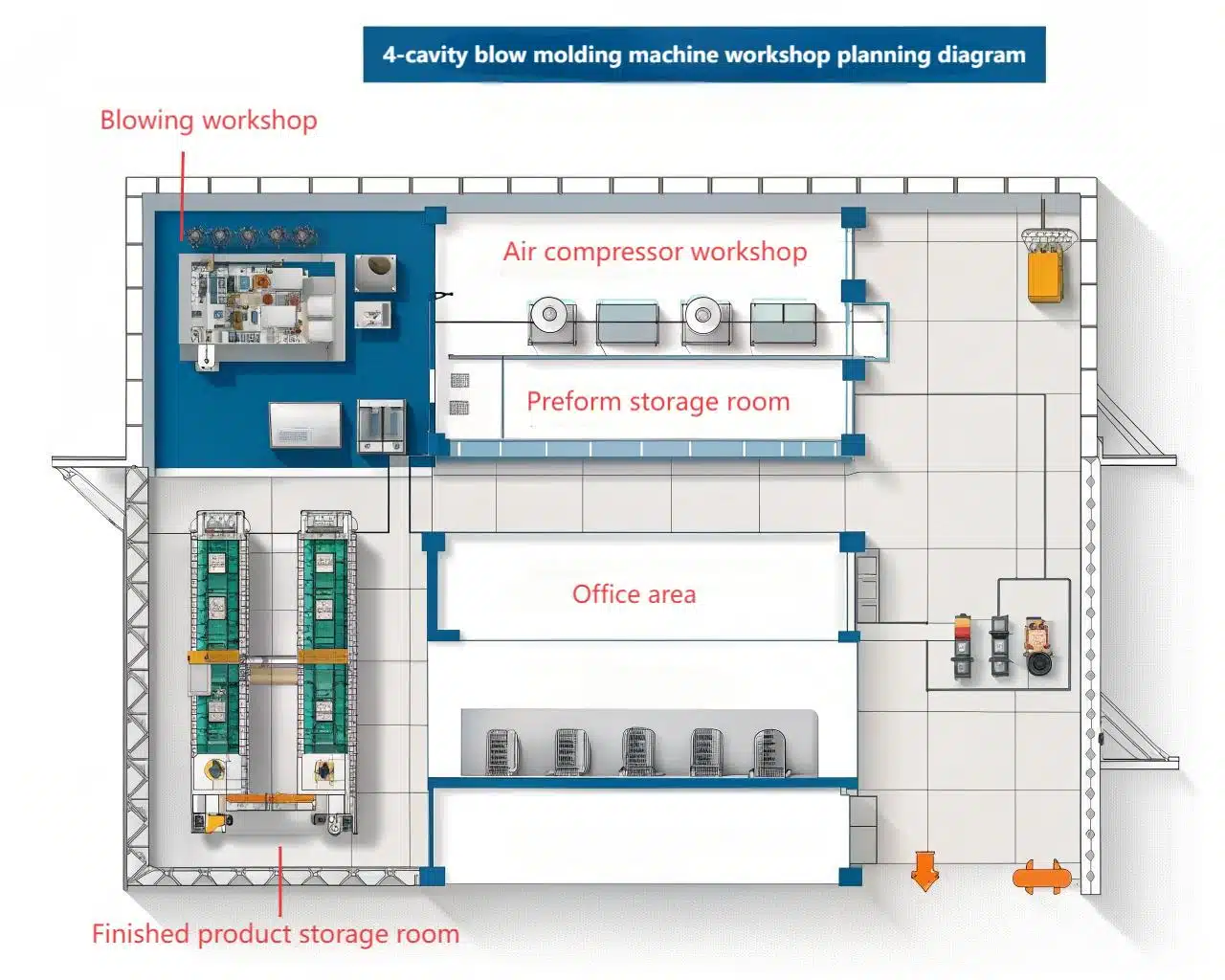
When I start a new turnkey project with a client, the first thing we do is a layout study. We don't just drop machines onto a floor plan; we simulate the entire workflow. We map out where the raw PET resin will be stored and dried. We plan the path of the preforms from the injection unit to the bottle blowing machine. We ensure there is adequate space around each piece of equipment for operators to work safely and for maintenance technicians to perform their duties without disrupting production. For my client in Cameroon, we designed a U-shaped layout that fit perfectly into a section of their existing warehouse, minimizing the need for new construction and making the best use of their available square footage.
Key Considerations for Your Plant Layout
A well-designed layout is essential for safety, efficiency, and future growth. Here are the critical areas to plan for:
-
Raw Material & Utility Zone:
- Resin Storage & Drying: This area should be clean, dry, and located near the injection molding machine to minimize the length of the material feed lines. You'll need space for a vacuum loader and a dehumidifying dryer.
- Utilities: The water chiller and high/low-pressure air compressors are the heart of your line's support system. They can be noisy, so it's often best to place them in a separate utility room or a designated, sound-dampened area with good ventilation.
-
The Production Core:
- Injection & Blowing: The injection molding machine and the bottle blowing machine form the core of your line. They should be positioned to allow for a smooth, automated transfer of preforms. A linear arrangement is common and efficient. Ensure you leave at least 3-4 feet (about 1 meter) of clear space around the machines for safe operation and maintenance access.
- Mold Storage: You'll need a safe, clean area to store your expensive preform mold and blow bottle mold when they are not in use. A sturdy racking system is a must.
-
Post-Production & Logistics:
- Conveying & Packing: Plan the path for the finished jars. An outbound conveyor will move the jars from the blowing machine to a packing station. You need to allocate space for packing tables, boxes or bags, and a temporary storage area for finished pallets.
- Quality Control Station: Designate a small area with good lighting where operators can perform regular quality checks on the finished jars.
A logical flow—from raw materials in, to finished goods out—prevents bottlenecks and makes the entire operation run more smoothly.
Why Choose Us as Your Turnkey Partner for Wide-Mouth Jars?
Embarking on an in-house production project can feel overwhelming. You need more than just a machine supplier; you need a partner with deep industry experience who can guide you from concept to successful, profitable production.
You should choose us because we offer more than just machinery. With 16 years of hands-on experience, we provide a complete, customized turnkey solution, covering everything from mold design and line integration to long-term support, ensuring your project is a success.
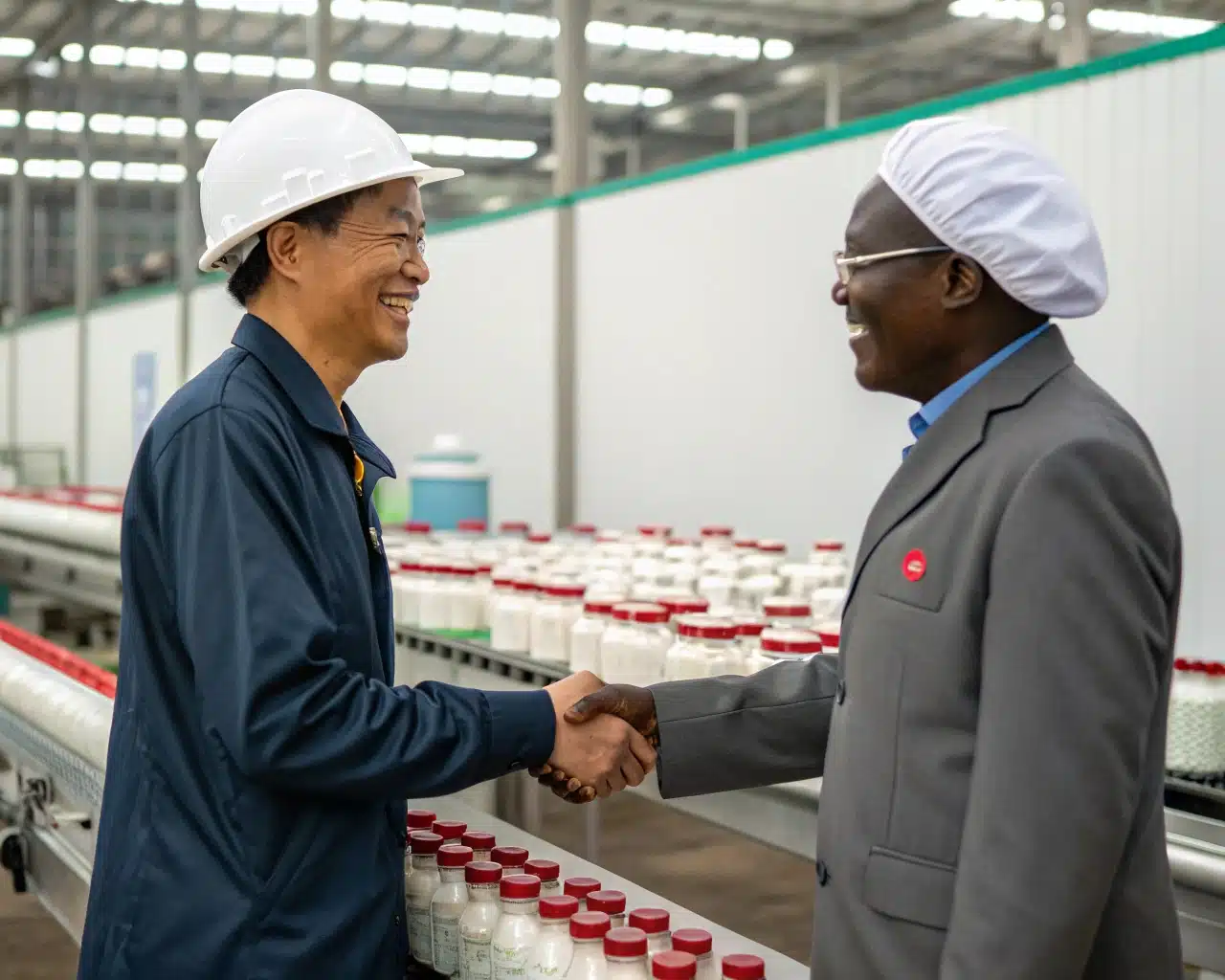
This is what I do. My passion is helping businesses like yours take control of their production and unlock their potential. The success of my Cameroonian client is a story I am incredibly proud of. They wanted to enter the wide-mouth jar market but didn't know where to start. We worked together every step of the way. I helped them design the perfect candy jar and the corresponding preform mold. We selected the right injection machine and a custom bottle blowing machine. We planned the factory layout. The entire process, from our first conversation to them running mass production, took just a few months. Their satisfaction and their plan to add new jar varieties is the best feedback I can receive.
Our Comprehensive Partnership Approach
We believe a successful project is built on a foundation of trust, expertise, and comprehensive support.
- Deep Expertise: My 16 years in the PET packaging industry are at your disposal. I understand the nuances that separate successful projects from failed ones. I know the market, the technology, and how to avoid common pitfalls.
- True Turnkey Solutions: We handle everything. You don't have to coordinate with a dozen different suppliers. We design, source, integrate, and install the complete line: injection molder, dryer, chiller, compressor, molds, blowing machine, and automation. It's a single, seamless package with one point of responsibility.
- Customization at the Core: Your product is unique, and your production line should be too. We don't sell one-size-fits-all solutions. We start with your jar—its size, shape, and weight—and design the entire system around it, from a custom blow bottle mold to a perfectly matched blowing machine.
- End-to-End Project Management: We are with you from the initial design sketches to the moment your team is producing thousands of high-quality jars per hour. We oversee manufacturing, shipping, installation, and on-site training to ensure a smooth and rapid launch.
- Long-Term Support: Our relationship doesn't end when the machines are running. We provide ongoing technical support, spare parts, and advice to help you optimize performance, maintain your equipment, and grow your business.
Choosing the right partner is the single most important decision you will make in this process. It's the difference between buying a set of machines and investing in a guaranteed outcome.
Conclusion
Bringing your PET wide-mouth jar production in-house is a strategic decision that replaces uncertainty with control, cuts long-term costs, and empowers your brand to stand out in a competitive market.
Frequently Asked Questions (FAQ)
1. How much capital do I really need to start an in-house PET jar production line?
The investment varies significantly based on the jar size, output required, and level of automation. A complete turnkey line can range from a hundred thousand to over a million dollars. However, we can provide a detailed quote based on a thorough analysis of your specific needs, along with an ROI calculation to show you how quickly the investment will pay for itself through operational savings.
2. We are tight on factory space. What is the minimum area required for a production line?
You might be surprised by how compact a modern, integrated line can be. Through clever layout planning (e.g., linear or U-shaped), a complete line for moderate production can often fit into an area as small as 1,000-1,500 square feet (around 100-140 square meters). We specialize in designing layouts that maximize the use of your existing space.
3. We don't have skilled plastics engineers. How difficult is it to operate the equipment?
Modern production lines are highly automated and feature user-friendly PLC touch-screen controls. Our turnkey solution includes comprehensive on-site training for your operators and maintenance staff. We teach them everything from daily operation and quality control checks to routine maintenance and troubleshooting, ensuring they are confident and capable from day one.
4. What happens if a machine breaks down? How long will we have to wait for support and parts?
This is a critical concern and a key advantage of our partnership model. We provide robust after-sales support with access to technical experts who can often diagnose issues remotely. We also help you stock a recommended list of critical spare parts on-site to minimize downtime for common maintenance items. Our goal is to keep you running, not keep you waiting.
5. How long does the entire process take, from signing the contract to starting production?
A typical project timeline is between 4 to 6 months. This generally includes 2-3 months for machine and mold manufacturing and customization, 1 month for shipping, and about 1 month for on-site installation, commissioning, and staff training. We manage this entire timeline closely to get you into production as quickly as possible.
🔗 Learn More about PET Jar Production Technology
-
Injection Molding – Wikipedia
Explains how PET preforms for wide mouth jars are initially formed using injection molding. -
Blow Molding – Wikipedia
Describes the process of shaping heated preforms into jars using air pressure. -
Stretch Blow Molding – Wikipedia
Details the technology commonly used to manufacture PET containers with strength and clarity, including wide-mouth jars. -
Plastic Bottle – Wikipedia
Provides an overview of various plastic container types, materials, and applications. -
Bottle Design – Wikipedia
Covers the structural considerations for designing plastic bottles and jars, including neck diameter, thread types, and volume.
🔗 Related Pages on Our Website
-
Automatic Blow Molding Machines – iBottler
Discover our full range of customizable automatic PET bottle blow molding machines. -
Blow Bottle Mold – iBottler
Explore our precision blow molds designed for PET and PP bottles. -
Preform Mold – iBottler
Learn more about our high-precision preform molds suitable for various injection molding machines.
